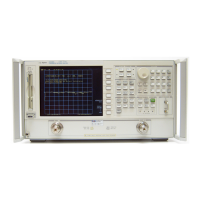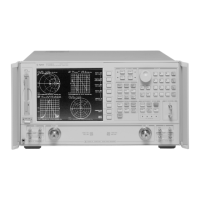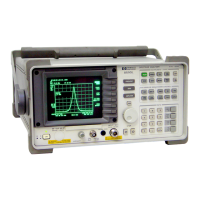7-20 Chapter 7
Source Troubleshooting
Phase Lock Error
A13/A14 Fractional-N Check
Use the analog bus or an oscilloscope to check the A14 VCO’s ability to sweep from 30 MHz
to 60 MHz. The faster analog bus method should suffice unless problems are detected.
Fractional-N Check with Analog Bus
1. Press
to switch on the analog bus and the fractional-N
counter.
2. Press to set the analyzer to CW mode.
3. Set the instrument as indicated in Table 7-5 and see whether the VCO generates the
frequencies listed.
4. Check the counter reading at the frequencies indicated.
• If the readings are within the limits specified, the probability is greater than 90%
that the fractional-N assemblies are functional. Either skip ahead to the “A7 Pulse
Generator Check” on page 7-25, or perform the more conclusive “A14 VCO Range
Check with Oscilloscope” described next.
• If the readings fail the specified limits, perform the “A14 VCO Exercise” on
page 7-22.
A14 VCO Range Check with Oscilloscope
1. Remove the W9 HI OUT cable (A14J1 to A7) from the A7 assembly and connect it to an
oscilloscope set for 50 ohm input impedance. Switch on the analyzer.
2. Press to
activate the FRACN TUNE service mode. See Chapter 10 , “Service Key Menus and
Error Messages,” for more information on the FRACN TUNE mode.
3. Vary the fractional-N VCO frequency with the front panel knob and check the signal
with the oscilloscope. The waveform should resemble Figure 7-17, Figure 7-18, and
Figure 7-19.
If the fractional-N output signals are correct, continue source troubleshooting by
skipping ahead to “A7 Pulse Generator Check” on page 7-25.
Table 7-5 VCO Range Check Frequencies
Instrument Setting Counter Reading
31 MHz 30 ±0.030 MHz
60.999999 MHz 60 ±0.060 MHz
Preset System
Meas
Menu
Preset System
